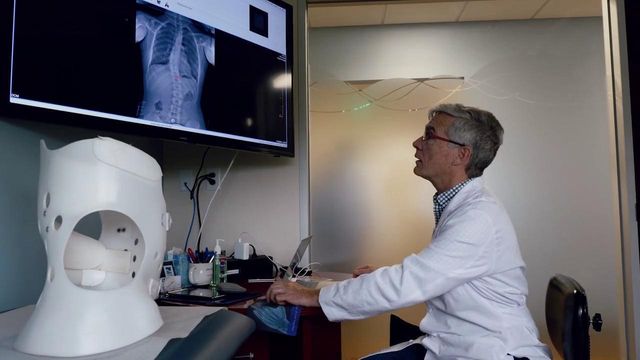How a Raleigh clinic is treating and correcting scoliosis
At Raleigh's Hey Clinic for Scoliosis and Spine Care, Dr. Lloyd Hey is utilizing conservative therapies and innovative technologies to halt and even reverse scoliosis in his patients.
Posted — UpdatedEach year, Oct. 16 marks World Spine Day — a time to bring attention to scoliosis, a condition millions of Americans live with. While scoliosis is a very common condition, it doesn't have to be debilitating.
At Hey Clinic for Scoliosis and Spine Care in Raleigh, Dr. Lloyd Hey has decades of experience screening, diagnosing, and treating scoliosis and other spine conditions. In fact, in 2005, he founded Hey Clinic, which he created to serve as a "living, learning lab" for quality, conservative, compassionate care and treatments.
Through his work, he is able to lessen the symptoms of scoliosis — and even reverse the diagnosis.
"Scoliosis is an abnormal curvature when you look at somebody from the front. For 97% of people, their spines are perfectly straight, but in the scoliosis patient, often with growing children, the spine starts to grow crooked, causing a lot of suffering later on," said Hey. "I see scoliosis in children, adolescents and adults. It's always important to try to catch it early, because you can actually prevent scoliosis from progressing."
There are several types of scoliosis, including:
- Idiopathic Scoliosis, the most common and with no known cause.
- Congenital Scoliosis, which starts before birth due to vertebrae forming incorrectly.
- Neuromuscular Scoliosis, caused by medical conditions like cerebral palsy and muscular dystrophy which leads to a muscle imbalance.
- Early Onset Scoliosis, which is present before 10 years of age.
- Degenerative Scoliosis, which is commonly seen in the lumbar spine of older adults, resulting from wear and tear on the joints and discs in the spine.
However, thanks to technological and research advancements, newer therapies are able to treat and often reverse scoliosis in a less invasive way than was previously possible.
"One treatment option is something called Schroth physical therapy and home exercise program. We have patients coming here to learn these exercises with a trained Schroth physical therapist, and then they go home and do their exercises for 15 or 30 minutes every day," said Hey. "What those exercises do is train the muscles to actually help straighten the spine to elongate it, so that they can find a corrected posture."
Thanks to these treatments, patients with scoliosis are able to resume their normal lives and hobbies. For patient Bailey Glynn, that meant being able to continue her cheerleading passion into her college career.
"I started out with a Boston Brace, which is kind of a dated version of the braces now, but recently after I was experiencing some pain levels with my spine and my back muscles while cheering in college, I reached out to Hey Clinic and started Schroth therapy," said Glynn. "It has helped me in ways that I never could have expected."
Glynn is right that technology has advanced quite a bit since she was wearing her brace — and Hey is excited to see how things like 3D CADCAM bracing will continue to influence scoliosis treatment and therapies.
"Right now with 3D technology, we can create an ultralight brace here using a 3D scan of the patient, and actually make a custom brace that fits like a glove, and it's less noticeable," said Hey "The combination of Schroth therapy with this new 3D CADCAM technology is allowing us to not halt scoliosis, but very often reverse it."
Related Topics
• Credits
Copyright 2024 by Capitol Broadcasting Company. All rights reserved. This material may not be published, broadcast, rewritten or redistributed.




